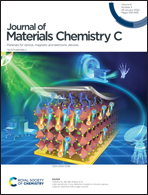Novel and dual-mode strain-detecting performance based on a layered NiO/ZnO p–n junction for flexible electronics†
Abstract
Conquering the limitations of flexible self-powered sensors by exploring their multifunctional heterostructure remains a fascinating issue. Herein, we present an initial electromechanical detector based on an n-ZnO/p-NiO heterojunction with excellent sensing properties for both static and dynamic strains. The whole heterostructure is fabricated on a flexible and conductive PET substrate via the facile RF magnetron sputtering method. It is noteworthy that the established electromechanical sensor can serve as a self-powered vibration detector with a sensitivity of 7.67 nA%−1, representing a high gauge factor (GF) of 196 in static strain monitoring (strain range from 0% to 1%). The dynamic strain sensing is realized by the piezoelectric effect enhanced by the heterojunction, while the static strain monitoring is attributed to the regulation of the ZnO energy band near the p–n junction. In applications, the device can be employed to detect human electrophysiological stimuli such as breathing and joint motion. We believe that the above results offer a worthy way to fabricate multifunctional strain detectors and a new route to design flexible self-powered sensors in the semiconductor industry.



 Please wait while we load your content...
Please wait while we load your content...